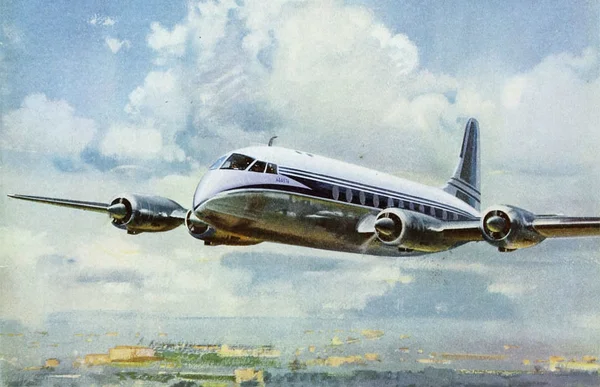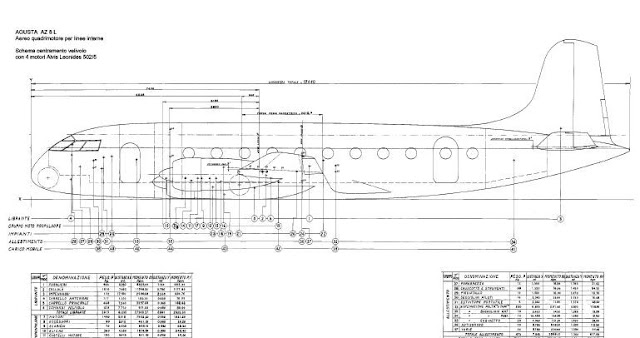L'Agusta A.Z.8 era un quadrimotore di linea ad ala bassa in grado di trasportare da 22 a 26 passeggeri a seconda delle versioni, realizzato dall'azienda italiana Agusta nel 1958 ma non avviato alla produzione in serie.
Pur essendo stato progettato per un impiego civile, l'unico esemplare realizzato venne preso in carico dall'Aeronautica Militare italiana ed impiegato come aereo da trasporto del personale fino alla sua radiazione.
Storia del progetto
Negli anni cinquanta l'Italia era impegnata nella ricostruzione del paese nel periodo che seguì il termine della seconda guerra mondiale. Tra i settori in sviluppo c'era anche quello del trasporto aereo civile che, grazie alla sovrabbondanza dei mezzi aerei surplus di derivazione militare di costruzione britannica e statunitense, equipaggiavano fin dalla fine del conflitto le compagnie aeree italiane. L'affluenza del traffico passeggeri in costante aumento e il raggiungimento della vita operativa di velivoli in dotazione segnò l'esigenza di disporre dei velivoli moderni e dotati di maggior capienza ed in quest'ottica l'azienda aeronautica italiana Agusta intraprese lo studio di un velivolo destinato al mercato civile.
Il progetto venne affidato all'ingegner Filippo Zappata, già autore di numerosi velivoli sia militari che civili del periodo prebellico e bellico, arrivato in azienda nel 1951 dopo la chiusura della divisione aeronautica della Società Italiana Ernesto Breda per Costruzioni Meccaniche e dopo aver realizzato il Breda BZ 308 mai avviato alla produzione in serie.
L'impostazione era classica, quadrimotore ad ala bassa ed impennaggio tradizionale monoderiva, con la capacità di raggiungere la velocità di circa 370 km/h a 3 000 m di quota. Un modello venne realizzato ed esposto allo stand dell'azienda in occasione del Salone internazionale dell'aeronautica e dello spazio di Parigi-Le Bourget del 1955 ma non riuscì a suscitare l'interesse sperato anche perché proposto ancora con motori a pistoni quando era imminente l'avvento dei motori turboelica.
Impiego operativo
Costruito in un solo esemplare (MM564, RS-1), venne utilizzato dall'Aeronautica Militare nel ruolo di aereo da trasporto tattico dal Reparto Sperimentale di Volo fino alla sua radiazione per mancanza di pezzi di ricambio. L'ultimo volo avvenne l'11 settembre 1963 e l'aereo venne demolito due anni dopo. Il velivolo non venne avviato alla produzione in quanto la Agusta ottenne la licenza di produzione di elicotteri dalla Bell e dalla Sikorsky, concentrandosi su questo specifico settore.
Versioni:
- A.Z.8N - versione da 22 posti a sedere con scompartimento passeggeri non pressurizzato.
- A.Z.8P - versione da 30 posti a sedere con scompartimento passeggeri pressurizzato.
Utilizzatori:
- Italia - Aeronautica Militare - L’ultimo volo dell'AZ8 non fu l'11 settembre 1963 ma più tardi, visto che io stesso ebbi occasione di effettuare un volo (come risulta dal mio libretto voli) il 19 ottobre 1963.
ENGLISH
The Agusta A.Z.8 was a four-engined low-wing line motor capable of carrying from 22 to 26 passengers depending on the version, built by the Italian company Agusta in 1958 but not started mass production.
Although it was designed for civil use, the only model produced was taken over by the Italian Air Force and used as a personnel transport aircraft until its radiation.
History of the project
In the fifties Italy was engaged in the reconstruction of the country in the period following the end of the Second World War. Among the sectors in development there was also that of civil air transport which, thanks to the overabundance of surplus aircrafts of British and US military derivation, equipped Italian airlines from the end of the conflict. The constant increase in passenger traffic and the achievement of the operational life of the aircraft supplied marked the need to have modern aircraft with greater capacity and, in this perspective, the Italian aeronautical company Agusta undertook the study of an aircraft destined for the civil market.
The project was entrusted to engineer Filippo Zappata, who had already designed numerous military and civil aircraft from the pre-war and war period. He arrived at the company in 1951 after the closure of the aeronautical division of the Italian Company Ernesto Breda for Mechanical Construction and after having built the Breda BZ 308, which had never started mass production.
The setting was classic, four-engined, low-winged and traditional single-derivative soaring, with the capacity to reach a speed of about 370 km/h at 3,000 m altitude. A model was produced and exhibited at the company's stand at the International Aeronautics and Space Show in Paris-Le Bourget in 1955, but it failed to arouse the desired interest because it was still proposed with piston engines when the advent of turboprop engines was imminent.
Operational use
Built in a single model (MM564, RS-1), it was used by the Air Force as a tactical transport aircraft from the Experimental Flight Department to its radiation due to lack of spare parts. The last flight took place on 11 September 1963 and the aircraft was scrapped two years later. The aircraft was not put into production as Agusta obtained the helicopter production licence from Bell and Sikorsky, focusing on this specific sector.
Versions:
- A.Z.8N - 22-seat version with unpressurised passenger compartment.
- A.Z.8P - 30 seats version with pressurised passenger compartment.
Users:
- Italy - Aeronautica Militare - The last flight of the AZ8 was not on 11 September 1963 but later, since I myself had the opportunity to make a flight (as shown in my flight booklet) on 19 October 1963.
(Web, Google, Wikipedia, You Tube)


















Nessun commento:
Posta un commento
Nota. Solo i membri di questo blog possono postare un commento.